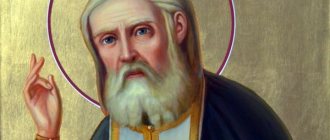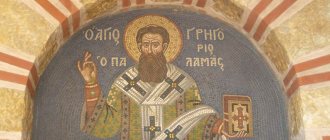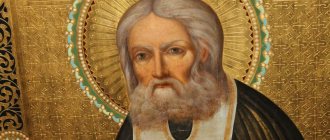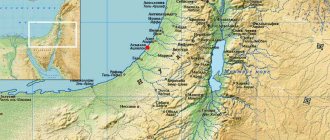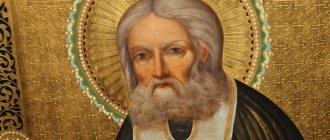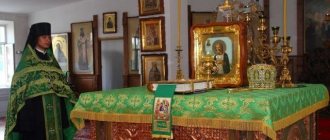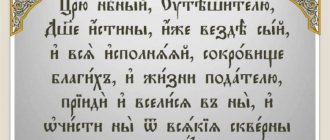Seraphim of Sarov
The Monk Seraphim of Sarov, a great ascetic of the Russian Church, was born on July 19, 1754. The saint's parents, Isidore and Agathia Moshnin, were residents of Kursk. Isidore was a merchant and took out contracts for the construction of buildings, and at the end of his life he began the construction of a cathedral in Kursk, but died before the completion of the work. The youngest son Prokhor remained in the care of his mother, who raised a deep faith in her son. After the death of her husband, Agafia Moshnina, who continued the construction of the cathedral, once took Prokhor with her there, who, having stumbled, fell from the bell tower. The Lord saved the life of the future lamp of the Church: the frightened mother, going downstairs, found her son unharmed. Young Prokhor, having an excellent memory, soon learned to read and write. Since childhood, he loved to attend church services and read the Holy Scriptures and Lives of Saints to his peers, but most of all he loved to pray or read the Holy Gospel in solitude.
One day Prokhor became seriously ill and his life was in danger. In a dream, the boy saw the Mother of God, who promised to visit and heal him. Soon a religious procession with the icon of the Sign of the Most Holy Theotokos passed through the courtyard of the Moshnin estate; his mother carried Prokhor out in her arms, and he venerated the holy icon, after which he began to quickly recover.
Even in his youth, Prokhor made the decision to completely devote his life to God and enter a monastery. The pious mother did not interfere with this and blessed him on the monastic path with a crucifix, which the monk wore on his chest all his life. Prokhor and the pilgrims set off on foot from Kursk to Kyiv to worship the Pechersk saints. The schemamonk elder Dosifei, whom Prokhor visited, blessed him to go to the Sarov hermitage and save himself there.
Returning briefly to his parents' house, Prokhor said goodbye to his mother and relatives forever. On November 20, 1778, he came to Sarov, where the wise old man, Father Pachomius, was then rector. He kindly received the young man and appointed Elder Joseph as his confessor. Under his leadership, Prokhor underwent many obediences in the monastery: he was the elder’s cell attendant, worked in the bakery, prosphora and carpentry shop, carried out the duties of a sexton, and performed everything with zeal and zeal, serving as if the Lord Himself.
By constant work he protected himself from boredom - this, as he later said, “the most dangerous temptation for new monks, which is cured by prayer, abstinence from idle talk, feasible handicraft, reading the Word of God and patience, because it is born from cowardice, carelessness and idle talk.” .
Already in these years, Prokhor, following the example of other monks who retired into the forest to pray, asked the elder’s blessing to also go into the forest in his free time, where he prayed the Jesus Prayer in complete solitude.
Two years later, novice Prokhor fell ill with dropsy, his body became swollen, and he experienced severe suffering. The mentor, Father Joseph, and other elders who loved Prokhor looked after him. The illness lasted about three years, and not once did anyone hear a word of grumbling from him. The elders, fearing for the life of the patient, wanted to call a doctor to him, but Prokhor asked not to do this, telling Father Pachomius: “I have given myself, Holy Father, to the True Doctor of souls and bodies - our Lord Jesus Christ and His Most Pure Mother...”, and wanted to be given Holy Communion. Then Prokhor had a vision: the Mother of God appeared in an indescribable light, accompanied by the holy apostles Peter and John the Theologian. Pointing her hand at the sick man, the Most Holy Virgin said to John: “This one is from our generation.” Then she touched the patient’s side with the staff, and immediately the liquid that filled the body began to flow out through the hole formed, and he quickly recovered. Soon, on the site of the appearance of the Mother of God, a hospital church was built, one of the chapels of which was consecrated in the name of the Monks Zosima and Savvaty of Solovetsky.
The Monk Seraphim of Sarov built the altar for the chapel with his own hands from cypress wood and always received the Holy Mysteries in this church.
After spending eight years as a novice in the Sarov monastery, Prokhor took monastic vows with the name Seraphim, which so well expressed his fiery love for the Lord and desire to serve Him zealously. A year later, Seraphim of Sarov was ordained to the rank of hierodeacon. Burning in spirit, he served in the temple every day, constantly praying even after the service. The Lord vouchsafed the monk visions of grace during church services: he repeatedly saw holy Angels serving with the brethren.
The Monk Seraphim of Sarov was granted a special vision of grace during the Divine Liturgy on Maundy Thursday, which was performed by the rector, Father Pachomius, and Elder Joseph. When, after the troparions, the monk said, “Lord, save the pious,” and, standing at the royal doors, pointed his orar at those praying with the exclamation “and forever and ever,” suddenly a bright ray overshadowed him. Raising his eyes, the Monk Seraphim saw the Lord Jesus Christ walking through the air from the western doors of the temple, surrounded by the Heavenly Ethereal Forces. Having reached the pulpit. The Lord blessed all those praying and entered the local image to the right of the royal doors. The Monk Seraphim of Sarov, looking at the wondrous phenomenon in spiritual delight, could not utter a word or leave his place. He was led arm in arm into the altar, where he stood for another three hours, his face changing from the great grace that illuminated him.
After the vision, the monk intensified his exploits: during the day he worked in the monastery, and spent his nights in prayer in a deserted forest cell. In 1793, at the age of 39, the Monk Seraphim of Sarov was ordained to the rank of hieromonk and continued serving in the church.
After the death of the abbot, Father Pachomius, the Monk Seraphim of Sarov, having his dying blessing for a new feat - living in the desert, also took the blessing from the new abbot - Father Isaiah - and went to a desert cell a few kilometers from the monastery, in a dense forest. Here he began to indulge in solitary prayers, coming to the monastery only on Saturday, before the all-night vigil, and returning to his cell after the liturgy, during which he received communion of the Holy Mysteries. The monk spent his life in severe exploits. He carried out his cell prayer rule according to the rules of the ancient desert monasteries; I never parted with the Holy Gospel, reading the entire New Testament during the week, and also read patristic and liturgical books.
The monk learned many church hymns by heart and sang them during his work hours in the forest. Near the cell he planted a vegetable garden and built a beekeeper. Earning food for himself, the monk kept a very strict fast, eating once a day, and on Wednesday and Friday he completely abstained from food. In the first week of Holy Pentecost, he did not take food until Saturday, when he received Holy Communion. The holy elder, in solitude, was sometimes so immersed in inner heartfelt prayer that he remained motionless for a long time, neither hearing nor seeing anything around him. The hermits who visited him from time to time - schemamonk Mark the Silent and hierodeacon Alexander, having caught the saint in such prayer, quietly withdrew with reverence, so as not to disturb his contemplation.
In the summer heat, the monk collected moss from the swamp to fertilize the garden; mosquitoes mercilessly stung him, but he complacently endured this suffering, saying: “Pasions are destroyed by suffering and sorrow, either voluntary or sent by Providence.”
For about three years the monk ate only one herb, snitis, which grew around his cell. In addition to the brethren, lay people began to come to him more and more often for advice and blessings. This violated his privacy. Having asked for the abbot’s blessing, the monk blocked women’s access to him, and then everyone else, having received a sign that the Lord approved of his idea of complete silence.
Through the saint’s prayer, the road to his deserted cell was blocked by huge branches of centuries-old pine trees. Now only birds, which flocked in large numbers to the saint, and wild animals visited him. The Monk Seraphim of Sarov fed the bear bread from his hands when bread was brought to him from the monastery.
Seeing the exploits of the Monk Seraphim of Sarov, the enemy of the human race armed himself against him and, wanting to force the saint to leave silence, decided to frighten him, but the monk protected himself with prayer and the power of the Life-giving Cross. The devil brought “mental warfare” upon the saint—a persistent, prolonged temptation.
To repel the onslaught of the enemy, the Monk Seraphim of Sarov intensified his labors by taking upon himself the feat of stylite mongering. Every night he climbed a huge stone in the forest and prayed with raised hands, crying: “God, be merciful to me a sinner.” During the day, he prayed in his cell, also on a stone that he brought from the forest, leaving it only for a short rest and strengthening his body with meager food. The saint prayed like this for 1000 days and nights.
The devil, disgraced by the monk, planned to kill him and sent robbers. Approaching the saint, who was working in the garden, the robbers began to demand money from him. The Monk Seraphim of Sarov had an ax in his hands at that time; he was physically strong and could have defended himself, but he did not want to do this, remembering the words of the Lord: “Those who take the sword will perish by the sword” (Matthew 26:52). Saint Seraphim of Sarov, lowering his ax to the ground, said: “Do what you need.” The robbers began to beat the monk, broke his head with a butt, broke several ribs, then, having tied him up, they wanted to throw him into the river, but first they searched his cell in search of money. Having destroyed everything in the cell and finding nothing in it except an icon and a few potatoes, they were ashamed of their crime and left.
The monk, having regained consciousness, crawled to his cell and, suffering severely, lay there all night. The next morning, with great difficulty, he reached the monastery. The brethren were horrified when they saw the wounded ascetic. The monk lay there for eight days, suffering from his wounds; Doctors were called to him, surprised that Seraphim of Sarov remained alive after such beatings. But the Monk Seraphim of Sarov did not receive healing from doctors: the Queen of Heaven appeared to him in a subtle dream with the apostles Peter and John. Touching the head of the monk, the Most Holy Virgin granted him healing. After this incident, the Monk Seraphim of Sarov had to spend about five months in the monastery, and then he again went to a desert cell.
Remaining bent forever, the Monk Seraphim of Sarov walked, leaning on a staff or hatchet, but forgave his offenders and asked them not to punish them. After the death of the rector, Father Isaiah, who had been his friend since the saint’s youth, he took upon himself the feat of silence, completely renouncing all worldly thoughts for the purest stand before God in unceasing prayer. If the saint met a person in the forest, he fell on his face and did not get up until the passerby moved away. The elder spent about three years in such silence, stopping even from visiting the monastery on Sundays. The fruit of silence was for St. Seraphim of Sarov the acquisition of peace of soul and joy in the Holy Spirit. The great ascetic subsequently spoke to one of the monks of the monastery: “...my joy, I pray you, acquire a peaceful spirit, and then thousands of souls will be saved around you.”
The new abbot, Father Nifont, and the elder brethren of the monastery suggested that Father Seraphim of Sarov either continue to come to the monastery on Sundays to participate in divine services and receive communion at the monastery of the Holy Mysteries, or return to the monastery. The Monk Seraphim of Sarov chose the latter, since it became difficult for him to walk from the desert to the monastery. In the spring of 1810, he returned to the monastery after 15 years in the desert. Without breaking his silence, he added seclusion to this feat and, without going anywhere or receiving anyone, he was constantly in prayer and contemplation of God. While in retreat, the Monk Seraphim of Sarov acquired high spiritual purity and was granted special grace-filled gifts from God - clairvoyance and miracle-working. Then the Lord appointed His chosen one to serve people in the highest monastic feat - eldership.
On November 25, 1825, the Mother of God, together with the two saints celebrated on this day, appeared in a dream vision to the elder and commanded him to come out of seclusion and receive weak human souls that required instruction, consolation, guidance and healing. Having been blessed by the abbot for a change in his lifestyle, the monk opened the doors of his cell to everyone. Seraphim of Sarov saw the hearts of people, and he, as a spiritual doctor, healed mental and physical illnesses with prayer to God and a word of grace.
Those who came to the Monk Seraphim of Sarov felt his great love and listened with tenderness to the affectionate words with which he addressed people: “my joy, my treasure.” Seraphim of Sarov began to visit his desert cell and a spring called Bogoslovsky, near which they built a small cell for him. When leaving his cell, Seraphim of Sarov always carried a knapsack with stones over his shoulders. When asked why he was doing this, the saint humbly answered: “I torment him who torments me.” In the last period of his earthly life, the Monk Seraphim of Sarov took special care of his beloved, brainchild - the Diveyevo women's monastery. While still in the rank of hierodeacon, he accompanied the late rector Father Pachomius to the Diveyevo community to see the abbess nun Alexandra, a great ascetic, and then Father Pachomius blessed the reverend to always take care of the “Diveyevo orphans.” He was a true father for the sisters, who turned to him in all their spiritual and everyday difficulties.
Disciples and spiritual friends helped Seraphim of Sarov to care for the Diveyevo community - Mikhail Vasilyevich Manturov, who was healed by the Monk Seraphim of Sarov from a serious illness and, on the advice of the elder, took upon himself the feat of voluntary poverty; Elena Vasilievna Manturova, one of the Diveyevo sisters, who voluntarily agreed to die out of obedience to the elder for her brother, who was still needed in this life; Nikolai Alexandrovich Motovilov, also healed by the monk.
N. A. Motovilov recorded the wonderful teaching of St. Seraphim about the purpose of Christian life.
In the last years of the life of the Monk Seraphim of Sarov, one healed by him saw him standing in the air during prayer. Saint Seraphim of Sarov strictly forbade talking about this before his death. Everyone knew and revered St. Seraphim of Sarov as a great ascetic and wonderworker. A year and ten months before his death, on the Feast of the Annunciation, the Venerable Seraphim of Sarov was once again honored with the appearance of the Queen of Heaven, accompanied by John the Baptist of the Lord, the Apostle John the Theologian and twelve virgins, holy martyrs and saints. The Most Holy Virgin talked for a long time with the monk, entrusting the Diveyevo sisters to him. Having finished the conversation, She told him: “Soon, My beloved, you will be with us.” At this appearance, during the wondrous visit of the Mother of God, one Diveyevo old woman was present, through the prayer of the monk for her.
In the last year of his life, the Monk Seraphim of Sarov began to noticeably weaken and spoke to many about his imminent death. At this time, he was often seen at the coffin, which stood in the entryway of his cell and which he had prepared for himself. The monk himself indicated the place where he should be buried - near the altar of the Assumption Cathedral.
On January 1, 1833, the Venerable Seraphim of Sarov came for the last time to the hospital Zosimo-Savvatievskaya Church for the liturgy and took communion of the Holy Mysteries, after which he blessed the brethren and said goodbye, saying: “Save yourself, do not lose heart, stay awake, today crowns are being prepared for us.”
On January 2, the monk’s cell attendant, Father Pavel, left his cell at six o’clock in the morning, heading to the church, and smelled a burning smell coming from the monk’s cell; Candles were always burning in the saint’s cell, and he said: “As long as I am alive, there will be no fire, but when I die, my death will be revealed by fire.” When the doors were opened, it turned out that books and other things were smoldering, and the Monk Seraphim of Sarov himself was kneeling before the icon of the Mother of God in a position of prayer, but already lifeless.
During prayer, his pure soul was taken by the Angels and flew up to the Throne of God Almighty, whose faithful servant and servant the Monk Seraphim of Sarov was all his life.
Holy relics
70 years after the death of the God-bearing elder, people came to his grave for consolation in sorrows, help and healing from illnesses. The saint had not yet been canonized, but thrones were already being prepared in his honor, a life and prayers were being compiled, and icons were being painted. And only in 1903, Elder Hieromonk Seraphim was canonized.
On his birthday (July 19), the discovery of his honest relics took place. After the revolution they disappeared.
Their second discovery took place only in 1991 in St. Petersburg, after which they were taken in a religious procession to the Trinity Seraphim-Diveevsky Monastery.
Miracles
Many miracles are associated with the name of the great elder. Through prayers to Blessed Seraphim, the dumb found their voices, the blind saw their eyes, the crippled were freed from lameness, and the paralyzed could move their limbs.
- The 19-year-old girl had cramped limbs, her hands were tightly clenched on her chest. After visiting the grave of Seraphim and bathing in the spring consecrated in the name of the God-bearer, the patient stood up independently, her arms and legs straightened, and she began to move independently.
- The peasant woman was paralyzed 6 years ago. She, immobilized, was brought to the spring and dipped in it three times. The woman was completely healed.
- A mother and her deaf-mute daughter took part in the procession. At the front of the procession, banner bearers carried the Face of the Virgin Mary and a large icon of Seraphim of Sarov. The woman placed the child next to the image of the saint and the baby immediately called out to her mother in her voice.
- At the grave of the miracle worker, a young woman who had completely lost her sight several years ago regained her sight.
There are cases where people were healed from insanity, paralysis, oncology and other serious illnesses. All facts of healings are recorded in the Chronicle of the monastery.

